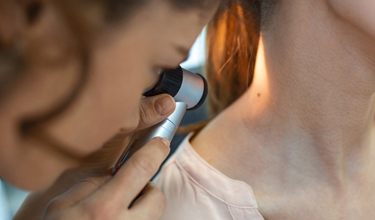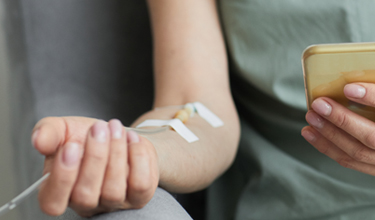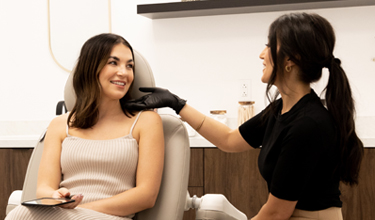Surgical skin cancer treatments
Surgery is a common treatment for skin cancers. There are various procedures available for non-melanoma skin cancers, and special options for melanoma skin cancer.
Excisions
Under local anesthesia, the tumor is removed with a surgical knife along with a wide margin of healthy skin to ensure all the cancer is removed. The wound is closed with stitches. The excised tissue is examined at a lab by a pathologist to assure that all cancerous cells have been removed. If the lab reports that cancer cells still exist, a second procedure will be necessary to reduce the risk of recurrence. Cure rates are close to 95%. Mohs surgery is a better option for skin cancers located in places like the face where it is important to save as much healthy tissue as possible.
Curettage and Electrodessication
Curettage and electrodessication are a good treatment for small superficial basal cell and squamous cell tumors. Under local anesthesia, the growth is scraped off and then burned with an electrocautery needle to destroy any remaining cancer cells. It will leave a circular whitish scar slightly larger than the size of the lesion.
Mohs micrographic surgery
Mohs micographic surgery is recommended for the removal of melanoma and nonmelanoma skin cancers. Mohs surgery reduces the risk of recurrence. Mohs surgery is recommended when:
- there is a significant risk the cancer can spread or reoccur
- it is difficult to determine the extent of the cancer
- when the tumor is an area where excision can cause disfiguration, and
- when the goal is to save as much healthy skin as possible such as when the tumor is on the face, eyes, lips and nose.
The procedure involves the removal of thin layers of the tumor. Each layer is examined under a microscope by Dr. Farhang to see if any cancer cells remain. This is repeated until a sample is free of cancer cells. While Mohs surgery can take several hours, the result is the preservation of healthy skin, the smallest scar achievable and the best cure rate possible.
Mohs surgery requires specialized training. Dr. Sheila Farhang is a board – certified dermatologist and fellowship – trained Mohs surgeon.
Nonsurgical treatments
Local treatments are designed to destroy very superficial tumors but have lower cure rates. Dr. Farhang will always provide you with information about all available options and her best recommendations.
Cryotherapy
Cryotherapy involves freezing the tumor when it is localized and has not spread. It is also commonly used for precancerous conditions like actinic keratosis. Depending on the patient, the type of skin cancer, and how early it is diagnosed, cryotherapy can also be used to treat very superficial nonmelanoma cancer.
The tumor is frozen using liquid nitrogen which kills the cancer cells. Repeated freezing may be necessary. 20-50% of patients experience side effects including pain, blisters, and the potential for hypo-pigmentation and scarring. An additional disadvantage is the inability to assure that all cancerous tissues have been removed.
Topical chemotherapy
Topical therapies are reserved for low – risk superficial tumors that don’t extend deep into the skin. The advantages of photodynamic therapy (PDT) and topical drugs are that they do not cause scarring and can treat wide areas of superficial skin cancer.
A significant disadvantage of these topical treatments is the inability to assure that all cancerous cells have been removed, because these treatments are limited in that they cannot reach deep in the skin. In addition, PDT can be painful during the procedure and inflammation including redness, erosions, pustules and crusts can last for 1-2 weeks.
Radiation
When the tumor is unable to be removed surgically because it is large or in an area difficult to reach, or the patient has other medical problems and cannot undergo surgery, radiation therapy may be recommended. Radiation therapy can cure small tumors. It may be combined with surgery to assure that all cancer cells have been killed.
Melanoma Treatment
Lymph node dissection
Melanoma first spreads to nearby lymph nodes. Lymph node dissection is a surgical procedure to remove lymph nodes near a melanoma that are abnormal.
Other melanoma treatments include Immunotherapy, targeted drug therapy, chemotherapy and radiation. If a melanoma is deep or metastasized Dr. Farhang will coordinate with your oncologists for optimal patient care.
When you have been diagnosed with skin cancer, you want a surgeon who will assure you receive the best treatment possible for you. Dr. Farhang is a board-certified dermatologist and Mohs surgeon. She is considered a skin cancer expert having written a text book chapter on the topic as well as an investigator and researcher in skin cancer chemotherapy clinical trials. Contact Avant Dermatology & Aesthetics in Tucson, Arizona to schedule a consultation today. Don’t wait. Early treatment can save your life.









 / 291 Reviews
/ 291 Reviews
socialize with avant
#naturalskin